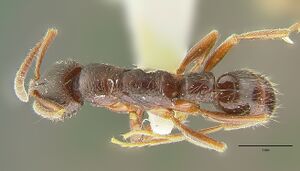Myopias cribriceps
| Myopias cribriceps | |
|---|---|

| |
| Scientific classification | |
| Kingdom: | Animalia |
| Phylum: | Arthropoda |
| Class: | Insecta |
| Order: | Hymenoptera |
| Family: | Formicidae |
| Subfamily: | Ponerinae |
| Tribe: | Ponerini |
| Genus: | Myopias |
| Species: | M. cribriceps |
| Binomial name | |
| Myopias cribriceps Emery, 1901 | |
Identification
Keys including this Species
Distribution
Latitudinal Distribution Pattern
Latitudinal Range: -5.333° to -8.297778°.
| North Temperate |
North Subtropical |
Tropical | South Subtropical |
South Temperate |
- Source: AntMaps
Distribution based on Regional Taxon Lists
Indo-Australian Region: Indonesia, New Guinea (type locality).
Distribution based on AntMaps
Distribution based on AntWeb specimens
Check data from AntWeb
Countries Occupied
| Number of countries occupied by this species based on AntWiki Regional Taxon Lists. In general, fewer countries occupied indicates a narrower range, while more countries indicates a more widespread species. |

|
Estimated Abundance
| Relative abundance based on number of AntMaps records per species (this species within the purple bar). Fewer records (to the left) indicates a less abundant/encountered species while more records (to the right) indicates more abundant/encountered species. |

|
Biology
Castes
   
| |
| . | Owned by Museum of Comparative Zoology. |
Nomenclature
The following information is derived from Barry Bolton's Online Catalogue of the Ants of the World.
- cribriceps. Myopias cribriceps Emery, 1901h: 156 (w.q.) NEW GUINEA (Papua New Guinea).
- Type-material: 1 syntype worker, 2 syntype queens.
- Type-locality: Papua New Guinea: Sattelberg (L. Biró).
- Type-depositories: HNHM, MSNG.
- Wheeler, G.C. & Wheeler, J. 1976a: 59 (l.).
- Status as species: Emery, 1911d: 94; Donisthorpe, 1948g: 133; Chapman & Capco, 1951: 67; Bolton, 1995b: 269; Probst, Guénard & Boudinot, 2015: 204 (in key).
- Distribution: Papua New Guinea.
Description
References
- Emery, C. 1901k. Formicidarum species novae vel minus cognitae in collectione Musaei Nationalis Hungarici, quas in Nova-Guinea, colonia germanica, collegit L. Biró. Publicatio tertia. Természetr. Füz. 25: 152-160 (page 156, worker, queen described)
- Wheeler, G. C.; Wheeler, J. 1976a. Supplementary studies on ant larvae: Ponerinae. Trans. Am. Entomol. Soc. 102: 41-64 (page 59, larva described)
References based on Global Ant Biodiversity Informatics
- Donisthorpe H. 1948. A fourth instalment of the Ross Collection of ants from New Guinea. Annals and Magazine of Natural History (12)1: 131-143.
- Emery C. 1901. Formicidarum species novae vel minus cognitae in collectione Musaei Nationalis Hungarici, quas in Nova-Guinea, colonia germanica, collegit L. Biró. Publicatio tertia. Természetrajzi Füzetek 25: 152-160.
- Emery C. 1911. Hymenoptera. Fam. Formicidae. Subfam. Ponerinae. Genera Insectorum 118: 1-125.
- Janda M., G. D. Alpert, M. L. Borowiec, E. P. Economo, P. Klimes, E. Sarnat, and S. O. Shattuck. 2011. Cheklist of ants described and recorded from New Guinea and associated islands. Available on http://www.newguineants.org/. Accessed on 24th Feb. 2011.
- Viehmeyer H. 1912. Ameisen aus Deutsch Neuguinea gesammelt von Dr. O. Schlaginhaufen. Nebst einem Verzeichnisse der papuanischen Arten. Abhandlungen und Berichte des Königlichen Zoologischen und Anthropologische-Ethnographischen Museums zu Dresden 14: 1-26.
- Wilson Edward O. 1959. Adaptive Shift and Dispersal in a Tropical Ant Fauna. Evolution 13(1): 122-144

